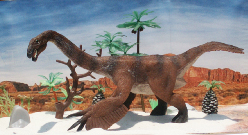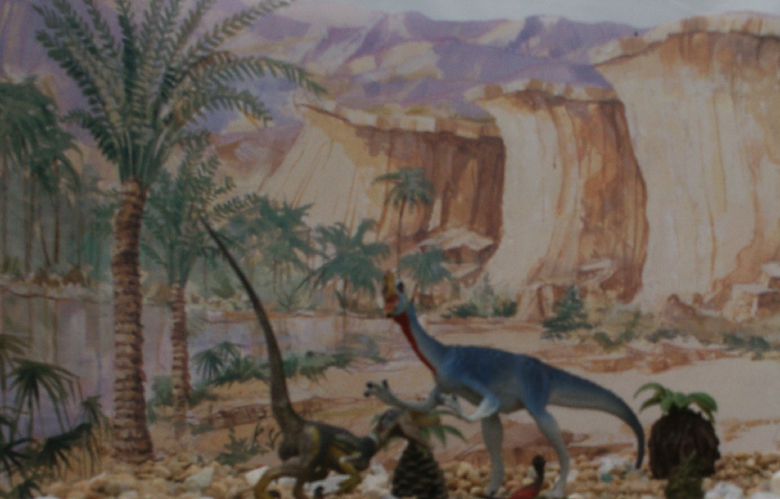
Late Cretaceous Asia
from the Dinosaur Collector
update 090306 proof 020606 rjk
THERIZINOSAUROIDEA Therizinosaurus, Beipiaosaurus, their most recent common ancestor and all its descendants. This family is so unlike other flesh eaters that they have sometimes been allocated their
own infra-order. There was at one stage considerable debate over their classification, with some preferring
to place them outside the theropods on the basis of a number of prosauropod likenesses, but more recent
discoveries have largely discounted this idea. They have theropod ankles, but 4 toes of roughly equal
length as opposed to the usual 3 plus one short toe of most other theropods. The pelvis is very similar to the
dromaeosaurids. Their inclusion as theropods was re-inforced by the finding of Alxasaurus in the Gobi
Desert (described in 1995).
They were bipedal and ponderous, with hip bones aligned like those of the plant eating, bird hipped
dinosaurs, and jaws with toothless beaks. Each foot had 4 toes pointing forwards and armed with long
claws. They may have swum and hunted fish, although their short beaks and small, lanceolate teeth argue
against this. It has been suggested that their claws may have been used to rip open termite mounds, but it is
difficult to believe that animals as large as Segnosaurus and especially Therizinosaurus could have
survived on such a diet. Their remains are typically found in river or lake sediments.
More Diorama Pages Asian Diorama Pages
Therizinosaurus (scythe lizard) had long arms (2.4 m/8 ft long) ending in fingers tipped with huge curved
claws. An incomplete claw measured 70 cm (2 ft) around the outer curve. Only the arms have been found
so far, but this is the largest and one of the youngest therizinosaurids (segnosaurids).

Safari Great Dinosaurs Therizinosaurus cheloniformis
Oviraptor (egg thief) was a two to three metres long maniraptoran theropod dinosaur with a weird beaked head sporting a helmet like crest structure just above the nostrils. The helmet was hollow, filled with wafer-thin bone structures that built intricate passages connecting with the nostrils. Mostly toothless, it had only two small, peculiar teeth on the palate, prompting a long debate about the feeding habits of the animal. The current consensus is that it was an omnivore, but most probably it was a meat-eater. The typical maniraptoran hands are heavily clawed and had a folding mechanism similar to Velociraptor. The wrist movement was supported by the semilunate carpal bone (just like birds). Oviraptor was fossilised in the act of protecting its nest, arms embracing at least twenty of its own eggs. This is evidence that some dinosaurs took care of their eggs in much the same way that birds do today and were exothermic.

Oviraptor from Carneige Safari. Baby Oviraptor and Velociraptor from UHA Kaiyodo.
Click on the Site A icon Dioramas organized by period or by manufacturer.